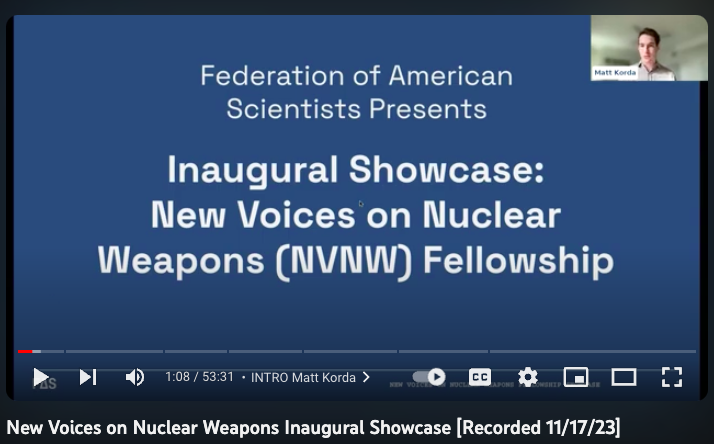A Reflection on the 2023 Hiroshima ICAN Academy
The views expressed herein belong solely to the author and do not necessarily reflect those of the U.S. Government.
As I stood outside of the Hiroshima Prefectural Industrial Promotion Hall, now memorialized as the Atomic Bomb Dome, I was amazed by the profound stillness of the park even though it sat in the shadow of the city’s tall buildings beside busy streets filled with cars and pedestrians.
I glanced at an image on my phone of the area taken several days after the bomb dropped. The Atomic Bomb Dome stood defiantly amidst the wasteland of flattened buildings and burnt rubble. Now, it stood beside large green trees and towering apartment buildings in the gaze of a large athletic stadium. I had learned that the river beside me, now full of boats bringing tourists to the nearby Miyajima Island, was once filled with bodies of people who sought a brief relief for their burning flesh. I tried to imagine how this peaceful and modernized city looked in 1945, but visualizing such horror was beyond my imagination.
Without intentionally traveling to the Peace Park in Hiroshima, one could almost entirely overlook the city’s tragic history. Amidst the modern stores, apartment buildings, and restaurants, several buildings that survived the atomic bomb blast have been preserved, bearing the heavy weight of Hiroshima’s legacy. They remember the flattened buildings, waves of fire, black rain, and harrowing human cries for water.
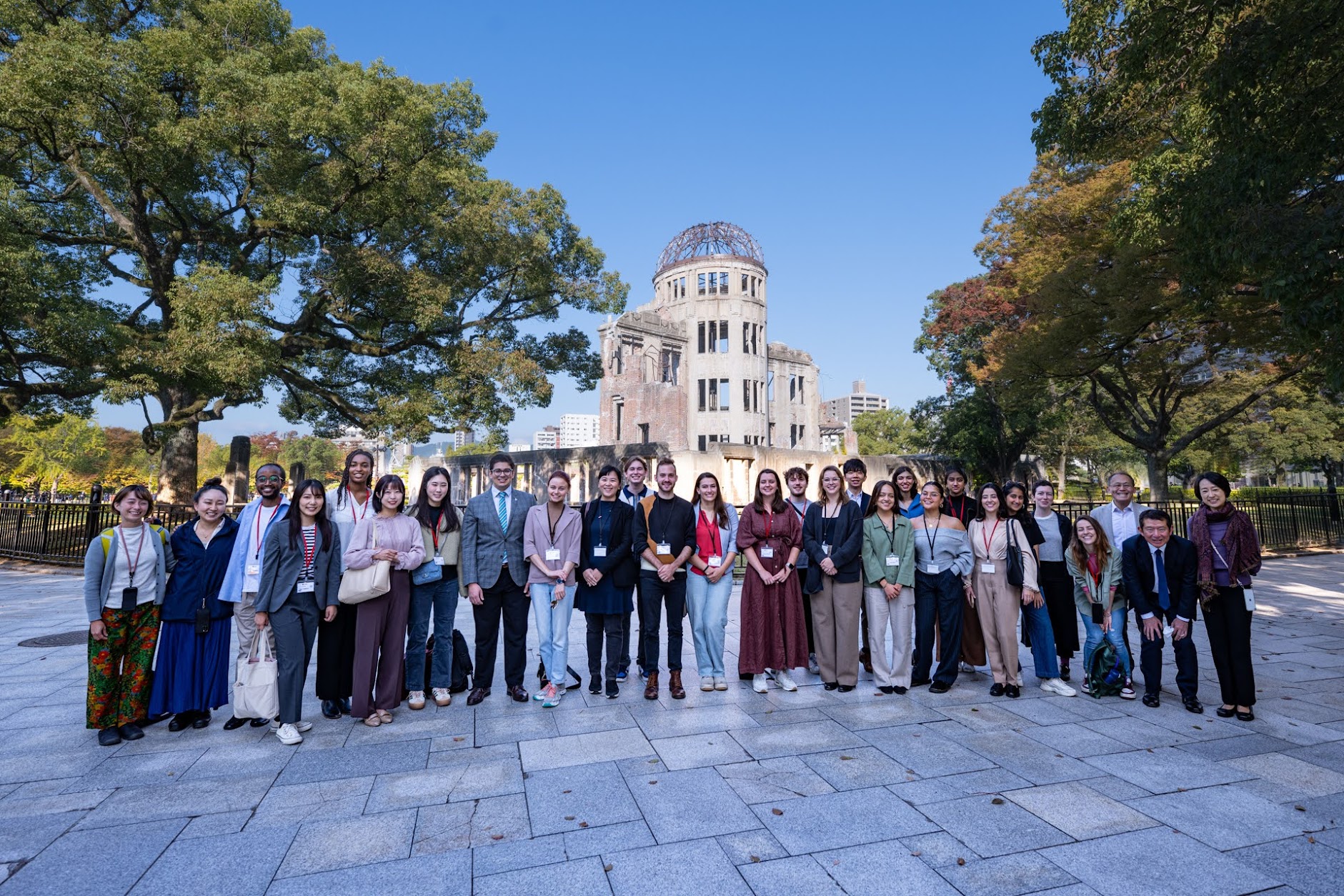
The New Voices on Nuclear Weapons Fellowship at the Federation of American Scientists helped me enter the field with no prior knowledge of nuclear weapons, let alone deterrence theory and the history of nuclear proliferation. I can confidently say that without this fellowship opportunity, I would not have thought I could have the authority to speak about nuclear weapons.
Many conversations and debates about nuclear weapons are rooted in complicated theories and hypothetical scenarios, making it difficult to join the discussion. While I believe it’s challenging for any human brain to fully internalize nuclear weapons’ lethal capacity, we can comprehend how nuclear weapons surpass the threats posed by other forms of warfare in terms of their destructive and indiscriminate potential.
I applied to the 2023 Hiroshima-ICAN Academy on Nuclear Weapons and Global Security to conceptualize the true destructive power of a nuclear weapon. Prior to the academy, I believed indisputable international norms prevented government officials from accepting disarmament and abolition as plausible nuclear policy guidelines. In speaking with hibakusha and many young activists in Japan, my preconceived notion was challenged; I learned that the propensity to dismiss the feasibility of nuclear abolition is not innate. Those who have experienced the apocalyptic repercussions of a nuclear weapon not only endorse the necessity of abolition but themselves underscore that the pursuit of disarmament is not just a policy objective but a moral responsibility—one that demands collective action and a commitment to preventing future generations from experiencing the unspeakable tragedies of the past.
The 2023 Hiroshima-ICAN Academy on Nuclear Weapons and Global Security is organized by Hiroshima Prefecture and the International Campaign to Abolish Nuclear Weapons (ICAN), the 2017 Nobel Peace Prize laureate. The goal of the program is to educate young leaders who can make concrete contributions toward a more peaceful and secure world. In addition to several peers from the United States, I joined other participants from China, Italy, India, Kenya, Lebanon, Ukraine, and more.
The 2023 Hiroshima-ICAN Academy hosted several online lectures and four days of educational sessions in Hiroshima, Japan. Online webinars gave participants the opportunity to interact with famous activists, such as Koko Kondo, Mary Dickson, and Melissa Parke, and hear from esteemed professionals in the nuclear field like Dr. Vincent Intondi and Izumi Nakamitsu. We learned about the suffering of downwinders in the United States, ICAN’s initiatives towards abolition, the UN’s disarmament efforts, and the racial history of nuclear weapons testing and usage. Prior to the online portion of the academy, I knew nothing of the intersectionality of nuclear weapons threats.
While in Hiroshima, we had a busy week of meetings, lectures, and tours, including a guided tour of the Peace Park and meetings with Hiroshima Mayor Kazumi Matsui, Hiroshima Governor Hidehiko Yuzaki, and atomic bomb survivor Keiko Ogura. Together, we learned about Hiroshima nonprofit efforts to support atomic bomb survivors, discussed the ecological effects and colonial history of nuclear weapons testing, and planned how to effectively interject discussions about disarmament in our respective communities.
The most memorable part of the ICAN Academy for me was speaking with atomic bomb survivors, also known as hibakusha. I was fortunate to spend several hours with hibakusha Ms. Sadae Kasaoka, who was 12 years old when the atomic bomb dropped. Ms. Kasaoka urged all of the Hiroshima ICAN participants to share her story with our communities.

I was struck by Ms. Kasaoka’s bravery and resilience. No human wants to dwell on the most traumatic experience of their lives, let alone recount it for hundreds of listeners each year. However, Ms. Kasaoka has been doing so year after year for the benefit of our education.
Like many children in Japan during World War II, Ms. Kasaoka would help demolish wooden houses to prevent the spread of fire after air raids. Her life consisted of work, rushing to bomb shelters, and fearing for her family. On the morning of August 6, 1945, Ms. Kasaoka was in her home when the atomic bomb was dropped. Ms. Kasaoka saw a blast of light through the window of her home and was knocked down by the initial blast of the bomb. Hours later, the images she would see in her town would be seared into her memory forever.
During our conversation with Ms. Kasaoka, she recounted the destruction of her friends’ homes and vividly remembered watching humans walk up the mountain, skin hanging off of their bodies like ghosts. When her father was brought back to the house on a stretcher several hours later, she did not recognize him because his face had significantly swelled and his skin was burnt black. She would spend the next two days applying cucumbers and potatoes to his skin to cool the burning while picking maggots out of her father’s flesh as he pleaded with her for water. Later, she would be brought a bag of ashes and hair, allegedly belonging to her mother. The atomic bomb would leave Sadae Kasaoka an orphan like thousands of young Japanese children in Hiroshima and Nagasaki. In Ms. Kasaoka’s words, “This is the reality of war.” Her story is only one of hundreds of thousands.
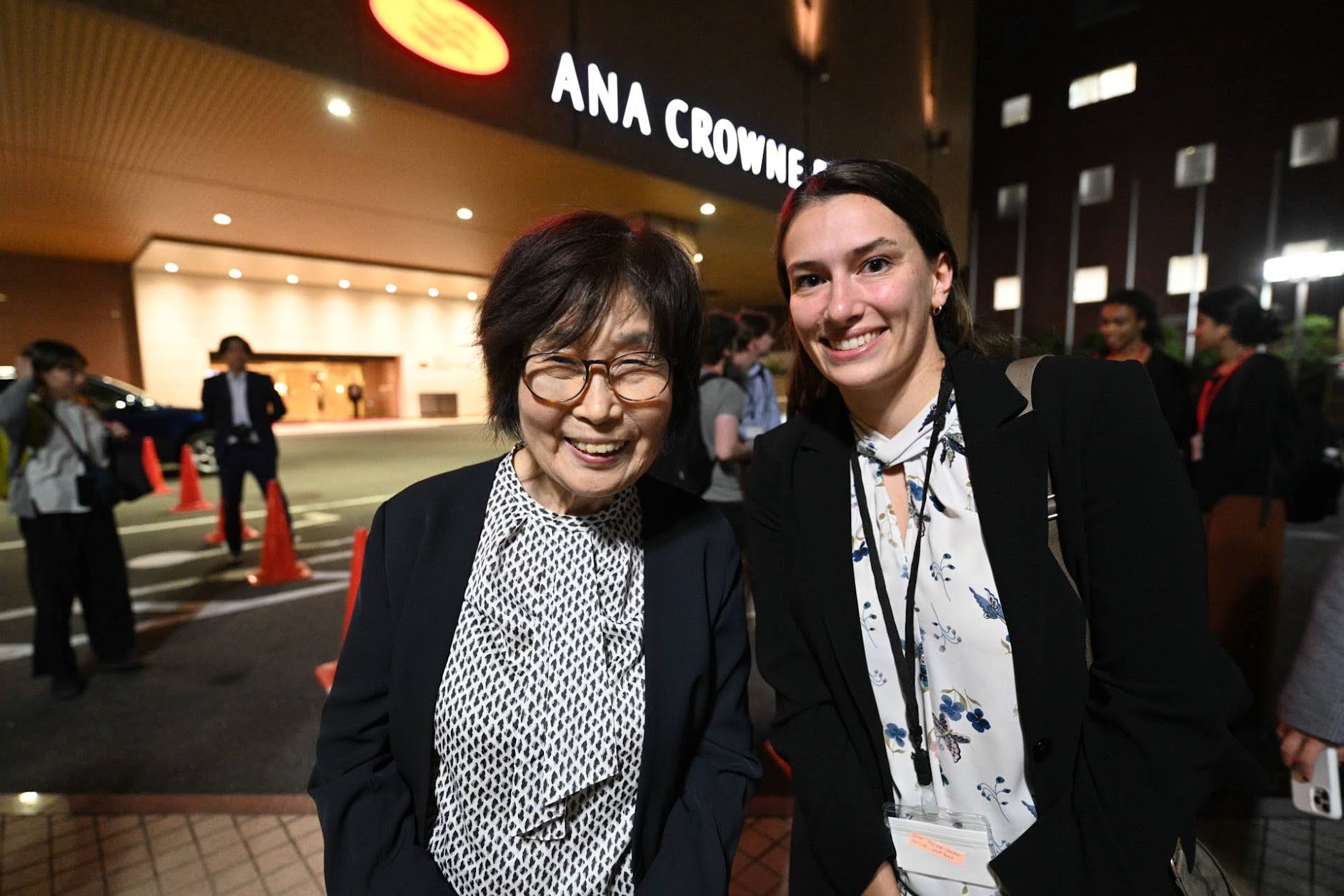
Prior to my fellowship with FAS, like many young Americans, I believed that nuclear weapons were a rusting relic of the past. At the end of my fellowship, I recognize these weapons are being cleaned and shined as arsenals expand and the risk of nuclear weapons use grows to be higher than at any time since the Cold War. Both FAS and the ICAN Academy led to my realization of a sobering truth: nuclear weapons cannot coexist with mankind indefinitely.
The Federation of American Scientists values diversity of thought and believes that a range of perspectives — informed by evidence — is essential for discourse on scientific and societal issues. Contributors allow us to foster a broader and more inclusive conversation. We encourage constructive discussion around the topics we care about.
New Voices on Nuclear Weapons Fellowship: Creative Perspectives on Rethinking Nuclear Deterrence
After decades of reductions in the number and salience of nuclear weapons, they are once again at the center of international security. All nine nuclear-armed states are updating their arsenals, and several are expanding them. But despite new military technology and new risks, the concepts underpinning nuclear deterrence have changed little since the height of the Cold War. It is more important than ever that the nuclear policy community recruit new voices from diverse demographic and socioeconomic backgrounds to bring new perspectives, skills, and ideas into the field.
To empower new voices to start their career in nuclear weapons studies, the Federation of American Scientists launched the New Voices on Nuclear Weapons Fellowship. Between May and August 2023, each of our inaugural fellows–Anna Pluff, Clara Sherwood, Cameron Vega, and Charlotte Yeung–was paired with a senior academic or policy expert (John Emery, Jamie Withorne, Alan Robock, and Lovely Umayam) to co-author a research project that provides a creative perspective on nuclear deterrence policy.
As a culmination of this year’s fellowship, FAS hosted a showcase featuring presentations by fellows on their research following a Q&A session, as well as remarks by FAS staff on the fellowship’s structure, goals, and role in empowering the next generation of nuclear policy experts. A recording of the showcase is available for viewing below.
Fellowship Showcase
Fellowship Projects and Publications
New Voices on Nuclear Weapons fellows have had their research projects published across a variety of mediums. Please see below the fellows’ project summaries and publications related to this fellowship to date; this list will be updated as their research continues to be finalized.
Anna Pluff
In the early years of the Cold War, many scientists from the Manhattan Project fervently believed in the idea of “One World or None” and promoted nuclear one worldism. Though the scientific profession had relatively little experience with public engagement before the 1940s, scientists banded together to stretch the political possibilities of professional modes of association to foster support for world government. Anna’s case study looks at the historic role that scientific activism played in nuclear policy through one-worldism and how scientific activism can become a viable force in rethinking deterrence today.
Publications
- “Failed visionaries: Scientific activism and the Cold War” The Bulletin of the Atomic Scientists.
- “What “Oppenheimer” Misses About The Decision to Drop the Bomb” Inkstick Media.
- “Manhattan Project Scientists Believed the Way We Get Out Alive is World Government” Inkstick Media.
Clara Sherwood
Targeted disinformation and rapid digital communication are complicating nuclear deterrence and crisis management in an unprecedented manner. While nuclear discussions have traditionally occurred privately between governments, in the 21st century, there are a myriad of different actors participating in global nuclear conversations. Clara’s research aims to describe how digital narratives from non-governmental actors are contributing to escalation management, nuclear discourse, and nuclear rhetoric in the context of the Russian-Ukrainian War.
Publications
- “Exiting Musk’s Twitter Has Compromised Nuclear Communication Channels” Inkstick Media.
- “How nongovernmental entities are tailoring their outreach to address nuclear escalation” The Bulletin of the Atomic Scientists.
Cameron Vega
American nuclear deterrence inherently relies on ethical principles dictating the appropriate use of nuclear weapons; however, these ethical principles insufficiently consider modern scientific modeling demonstrating the devastating climatic impacts of nuclear use. Cameron’s research aims to update the ethical principles underpinning American nuclear deterrence to account for the realities of how nuclear strikes would affect the local environment and global climate change.
Publications
- “The climate blind spot in nuclear weapons policy” The Bulletin of the Atomic Scientists.
Charlotte Yeung
The nuclear narratives told and believed today are rooted in how nuclear weapons are discussed in schools, culture, and locality. The branching narratives in America and Japan are particularly distinct and told through different forms of official narratives taught in textbooks, visual aesthetics, preservation of nuclear-related sites, movements, and the military-industrial complex. Charlotte’s exhibit and poetry ask how education and culture are the roots through which come the multidimensional nature of how Americans and Japanese learn about nuclear weapons and how those define the systems that shape public opinion about nuclear weapons today in those two countries.
Publications
- Culture Blast: Tracing Nuclear Narratives (Online Research Project Website)
- “Culture Blast At The Kurt Vonnegut Museum” Federation of American Scientists
Big Issues for Science Policy in a Challenging World: A Conversation with Dr. Alondra Nelson
The Federation of American Scientists (FAS) seeks to advance progress on a broad suite of contemporary issues where science, technology, and innovation policy can deliver dramatic progress. In recognition of her work in public service, FAS will honor Dr. Alondra Nelson with the Public Service Award next month alongside other distinguished figures including Senators Chuck Schumer (D-NY) and Todd Young (R-IN) for their work in Congress making the CHIPS & Science Act a reality to ensure a better future for our nation.
In addition to my role as Senior Fellow in Science Policy for FAS, I have the pleasure of chairing Membership Engagement for Section X, a governance committee of the American Association for the Advancement of Science (AAAS) focused on Societal Impacts of Science and Engineering. I had the honor of co-moderating a session featuring Dr. Alondra Nelson last week, titled Big Issues for Science Policy in a Challenging World—A Conversation with Dr. Alondra Nelson at the American Educational Research Association (AERA) in Washington D.C.
The hybrid event was co-organized with Section K (Social, Economic, and Political Sciences) and co-moderated with Dr. Barbara Schneider, John A. Hannah University Distinguished Professor in the College of Education and the Department of Sociology at Michigan State University and Immediate Past Chair of AAAS Section K. We led a targeted Q&A discussion informed by audience questions in-person and online.
The conversation focused on how scientific and technical expertise can have a seat at the policymaking table, which aligns with the mission of FAS, and provided key insights from an established leader. Opening remarks featured reflections from Dr. Alondra Nelson on the current state of key issues in science policy that were priorities during her time in the Biden-Harris administration, and her views on the landscape of challenges that should occupy our attention in science policy today and in the future. Dr. Alondra Nelson is the Harold F. Linder Professor at the Institute for Advanced Study and a distinguished senior fellow at the Center for American Progress. A former deputy assistant to President Joe Biden, she served as acting director of the White House Office of Science and Technology Policy (OSTP) and the first ever Deputy Director for Science and Society.
FAS is highly invested in ensuring that federal government spending is directed towards enhancing our nation’s competitiveness in science and technology. Dr. Nelson emphasized the idea of innovation for a purpose, and how scientific research and technology development have the potential to improve society, including through STEM education and the infrastructure necessary for research investments to be successful. She also discussed how science and technology can advance democratic values, and highlighted three examples from her time at OSTP that provide promise for the future, including: the cancer moonshot; expanding access to federally funded research across the country; and the need for bringing new voices into science and technology.
Public trust in science and public engagement. The moderated discussion began with the idea of public trust in science in order to set the stage for the current policy landscape. We are operating in a low trust environment for science, and we should make scientific data more accessible to the public. She also highlighted that we need to engage the public in the design process of science and technology, which is why the OSTP Division of Science and Society was initially created. On this point, Dr. Nelson also said that “science policy is a space of possibility” and that we need to expand these opportunities more widely.
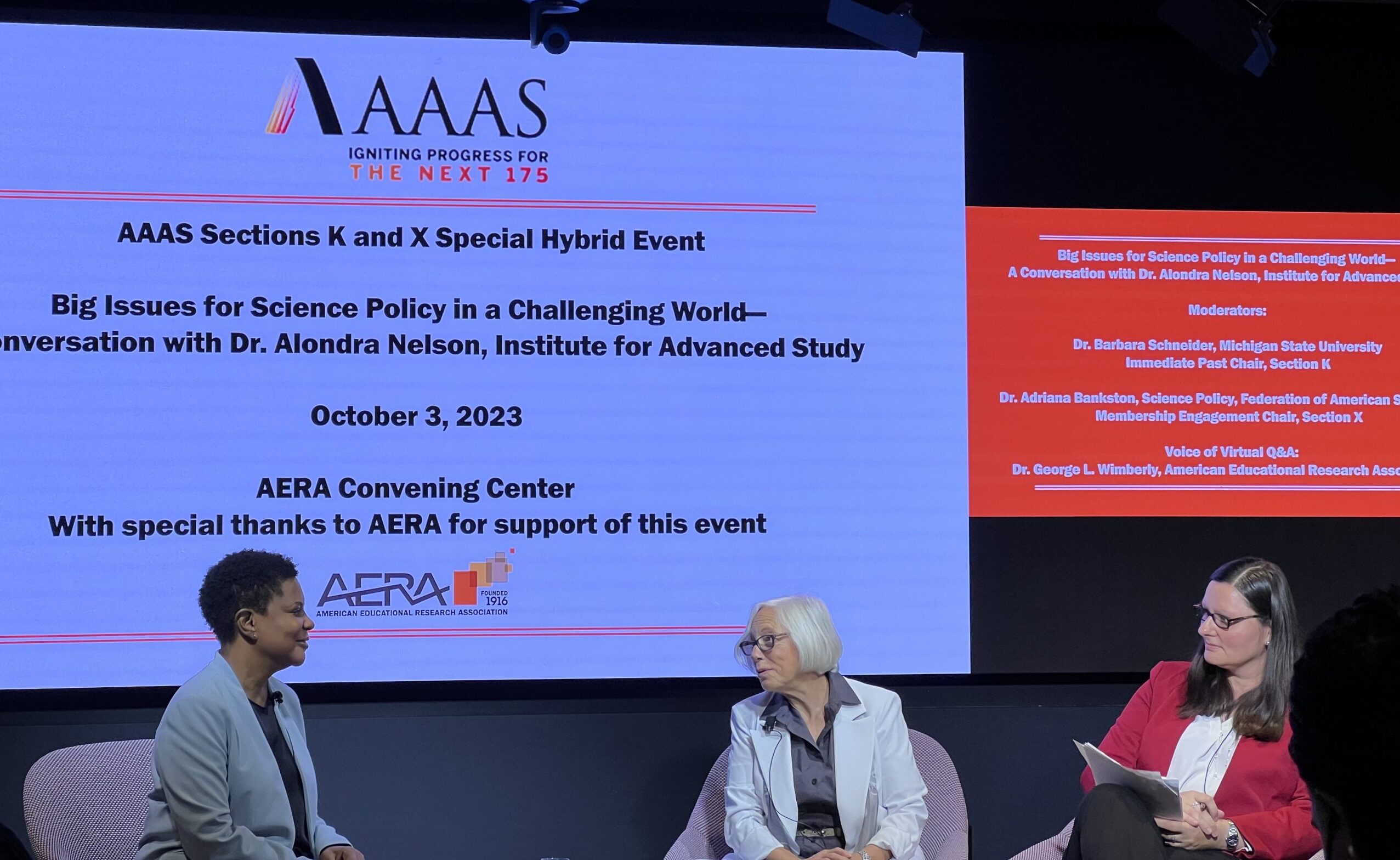
FAS Science Policy Fellow Adriana Bankston in conversation with Alondra Nelson at the American Educational Research Association.
Scientific workforce, federal investments and international collaboration. Dr. Nelson described the need to make the implementation of CHIPS and Science a reality and to bring more young voices into science and technology. She remarked that the promise of the CHIPS and Science Act is the intention around investments, and that “we need the ‘and science’ part to be fully funded in order to support the future scientific workforce.” To the question of how we should target federal investments in science and technology, she emphasized the need for collaborative research, bipartisan opportunities, and continuing to study the ‘science of science’ in order to understand the best ways for improving the system, while recognizing that the ROI from the investments we make today may take a few generations to be evident. Relatedly, on the question of ensuring our nation’s competitiveness in science and technology while fostering international collaboration, Dr. Nelson reminded the audience that “national security is a concern around many STEM areas of research.”
Including marginalized voices and technological development. A significant part of the conversation focused on ensuring that marginalized voices have a seat at the table in science and technology. Dr. Nelson stated bluntly that “you can’t have good science without diversity” and that we need to support institutions across the country and engage with different types of educational institutions that may have been traditionally marginalized. To this end, as an example, she emphasized that OSTP previously engaged indigenous knowledge in its work around science and technology governance. The field of artificial intelligence (AI) was also discussed as an example of an area where we need to elevate the visibility of ethical issues that marginalized communities face. The CHIPS and Science Act focused on key technology areas that could create jobs in fields such as AI, leading to a discussion on the need for better policy around emerging technologies, creating high quality jobs, and a stronger focus on workers in the innovation economy.
The event concluded with a high level discussion on policy impact, to which Dr. Nelson remarked that “if you want your science to have an impact, you should find ways to elevate the visibility of your findings among policymakers.” She stated that this will necessitate expanding our current methods to include broader voices in science and technology in the future. We look forward to honoring Dr. Nelson’s impact in the field during next month’s FAS event.
Wins, Gaps, & Looking Forward in the U.S. Bioeconomy
September should be considered National Bioeconomy Month. This past September marked the one year anniversary of the 2022 Presidential Executive order on Advancing Biotechnology and Biomanufacturing Innovation for a Sustainable, Safe, and Secure American Bioeconomy (affectionately known as the Bioeconomy EO). SynBioBeta celebrated the occasion by organizing a Bioeconomy Product Showcase on Capitol Hill that highlighted many different companies within the bioeconomy and proudly boasted bipartisan support in attendance. FAS wrapped up the month by hosting a Bioeconomy & Biomanufacturing Hill Day and Dinner on September 28th, 2023. We brought in some of our subject matter experts to talk in-depth about their Day One Memos and other contributions with key members of Congress.
Highlights Hill Day & Dinner
- Workforce development for the bioeconomy was a hot topic. Our subject matter experts pointed to the need for workers that have interdisciplinary skill sets that include both bio and engineering or bio and computer science. Support for interdisciplinary fellowships (like the Department of Energy Computational Science Graduate Fellowship) could help fill this need. Robust training is needed at all levels of biomanufacturing processes, and could include internships, apprenticeships, and associates and bachelors degree programs.
- To create supply chain resiliency and be competitive with other nations in the global bioeconomy, it is imperative to reduce costs of producing inputs needed for biomanufacturing (e.g., amino acids for biopharma), and to produce these inputs within the U.S. Our current reliance on other countries, like China, for these materials makes our bioeconomy fragile and susceptible to disruptions.
- A successful U.S. bioeconomy needs a strategic framework that unites the different agencies working on different aspects of the bioeconomy, including investments (e.g., EDA Tech Hubs, DoD Biomanufacturing Strategy, and NSF BioFoundries) and regulatory oversight. Both the Bioeconomy EO and the CHIPS and Science Act of 2022 called for the creation of a coordinating office housed in the Office of Science and Technology Policy (OSTP), but there has been no movement to create this coordinating office.
- The bioeconomy also needs appropriate financing. Many startups face the challenge that funding from venture capital firms requires a fast turnaround time for a return on investment (typically 3-5 years). Due to the nature of the products that are produced, many biotech companies are unable to demonstrate their value so quickly. In addition, scaling from a laboratory benchtop to industrial-scale biomanufacturing is expensive and is seen as too risky for typical bank loans. For the bioeconomy to be economically viable, it will need financial measures (potentially, tax incentives, credits, or other financial programs) to support biomanufacturing so that companies can have a chance to show they are viable and valuable.
- To capture the economic value of the bioeconomy and the impact of investments in this sector, appropriate metrics and measurements are needed. In March of 2023, the Bureau of Economic Analysis (BEA) published a feasibility report that indicated that it would be difficult to measure all aspects of the bioeconomy due to a lack of consensus definition, but a satellite account could be created to track aspects of the bioeconomy. However, in order for the BEA to create this type of account, Congress would need to appropriate the funds and direct the BEA to do so.
- Executive branch agencies are working towards a prosperous and resilient bioeconomy that is competitive at the global level, but these agencies can only do so much without Congressional champions on the Hill to keep fighting and funding the programs needed to achieve this.
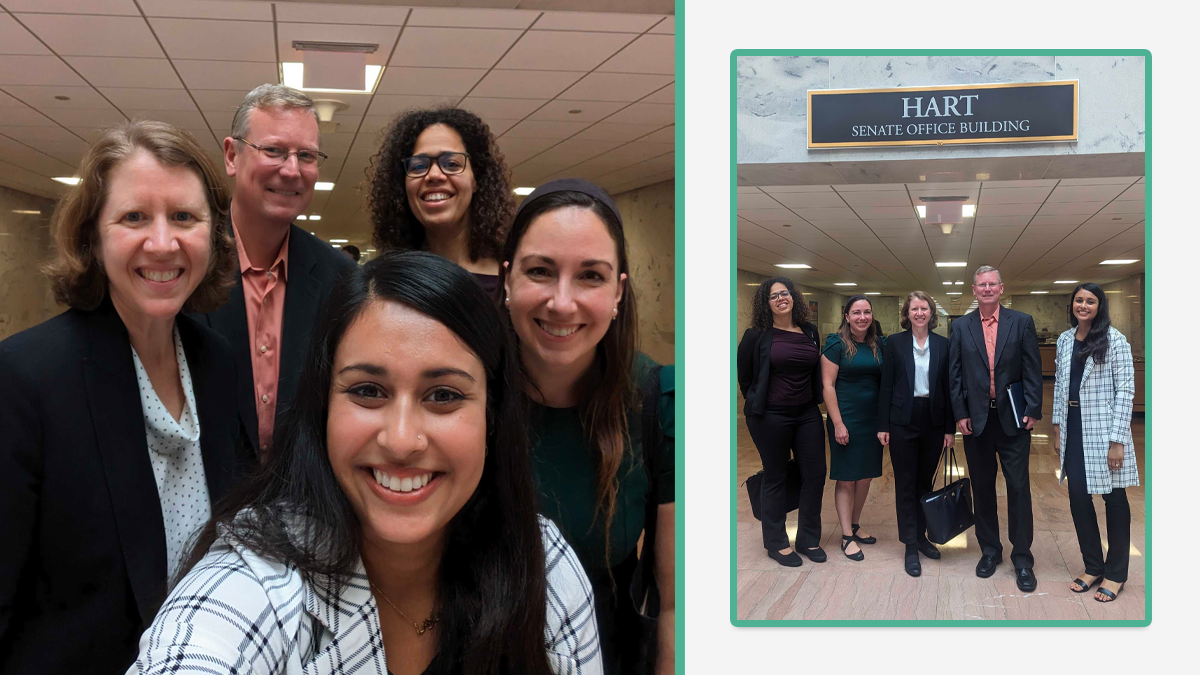
Dr. Nazish Jeffery, Dr. Sarah Carter, Dr. Allison Berke, Dr. Chris Stowers, and Dr. Sarah Richardson representing the Federation of American Scientists at the Bioeconomy & Biomanufacturing Hill Day and Dinner
Next Year is Critical for the Bioeconomy
In a short timespan, several federal agencies have pushed the needle forward in terms of the U.S. bioeconomy, however there is no shortage of work left in order to achieve a “Sustainable, Safe, and Secure” bioeconomy. For the next year, we would like to see an updated definition of the U.S. bioeconomy that accounts and specifies sectors that are and are not part of the bioeconomy and takes sustainability as its main priority. In addition, the National Institute of Standards and Technology (NIST) should update the Bioeconomy Lexicon and prioritize setting standards for biomanufacturing that utilizes a sector to sector approach instead of an overarching standards approach to ensure that innovation is not stifled by standards that do not allow for the flexibility needed in the biotech space.
Additionally, it will be vital for the federal government to enact a true framework for the U.S. bioeconomy by creating a coordinating office housed in OSTP that works with the various federal agencies focused on the bioeconomy and provide support to publish the reports directed by the Bioeconomy EO on time. Furthermore, in order to achieve products, goods, and services that are sustainable, secure, and safe, it will be essential for the coordinating office to gather public opinions in order to help shape and influence our bioeconomy.
Increased congressional involvement is also necessary to address key challenges the bioeconomy currently faces, such as the inability to measure the bioeconomy and the challenge that companies within the bioeconomy face (such as incomplete knowledge on processes relating to creating a startup, scaling goods and serves, and navigating the regulatory system). The BEA should be directed by Congress to create a satellite account to measure the U.S. bioeconomy and Congress should mandate a public-private driven landscape analysis on the current financial situation of the U.S. bioeconomy in order to be able to identify the gaps in financing the sector currently faces.
There is no doubt that the bioeconomy has potential to grow, but it needs a solid framework to stand upon. Implementing some or all of these ideas will not only lead to a prosperous bioeconomy, but it will also create one that is resilient, sustainable, and secure.
The FAS-OMB Evidence Forum: Thinking Back and Looking Forward
Until a month ago, I was an event skeptic.
When it’s as easy as a Zoom link to connect with colleagues, I found it hard to believe that getting a bunch of people together around an agenda was ever really worth the time and effort.
Point one for my colleagues at FAS and the White House Office of Management and Budget (OMB), who thought that co-hosting an “Evidence Forum” in support of the White House Year of Evidence for Action was a good idea. And were completely right.
The FAS-OMB Evidence Forum, a half-day session in Washington, DC on October 7, 2022, proved that events can indeed drive forward progress when they include three key components: compelling ideas, effective champions, and an open structure that enables participants to identify intersections with their own work. Let’s touch on each of these in the context of the Evidence Forum.
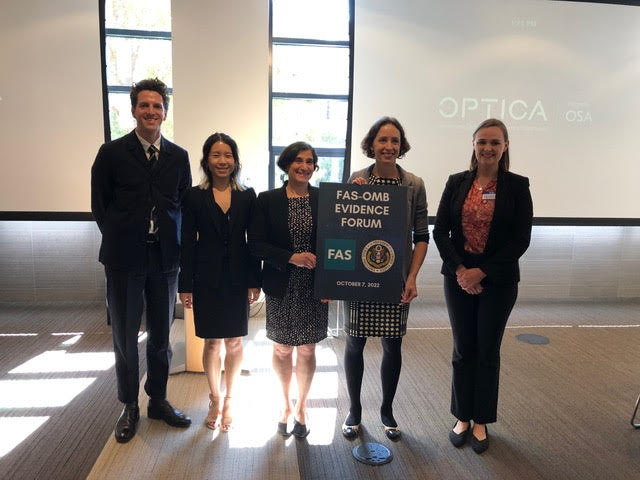
Compelling ideas
The Evidence Forum showcased four novel proposals for enhancing evidence-based policy and practice across federal government. Three of these ideas were developed through the “Evidence for Action Challenge” co-sponsored by FAS and the Pew Charitable Trusts Evidence Project. These ideas were:
- Incorporating evidence on what the public values into policymaking. For instance, public willingness to embrace various forms of climate-adaptation strategies can and should be considered alongside expert assessments when designing climate action plans.
- Using unmet desire surveys to facilitate productive collaboration among federal agency staff and external experts. Such surveys could, in particular, identify where federal staff could use help from others in advancing agency learning agendas.
- Launching an intergovernmental research and evaluation consortium focused on economic mobility. By linking datasets and creating reusable evaluation templates, such a consortium could enable cheap, fast, and reliable assessments of various economic programs.
A fourth idea also shared at the Forum was incorporating Living Evidence into federal initiatives. While traditional approaches to knowledge synthesis are often static and can quickly go out of date in rapidly evolving fields, Living Evidence uses thoughtfully designed, dynamic methodologies to produce knowledge summaries that are always current. This is especially important for topics where new research evidence is emerging rapidly, current evidence is uncertain, and new research might change policy or practice.
Effective champions
The Forum demonstrated how much more powerful ideas on paper become when articulated by someone who can give those ideas dimensionality and life. In an armchair discussion, Drs. Julian Elliott (Monash University) and Arlene Bierman (U.S. Agency for Healthcare Research and Quality) emphasized that Living Evidence is not a theoretical construct—it is already informing dynamic COVID-19 clinical-practice guidelines and shedding light on plant-based treatments as an alternative pain-management approach. Similarly, Kathy Stack (Yale University) drew on her extensive past experience at OMB to illustrate why intergovernmental partnerships are crucial for improving evaluation and delivery of programs that serve overlapping populations.
The Forum elevated newer voices as well. Postdoctoral research associate Nich Weller (Arizona State University) argued that while federal evidence efforts acknowledge the importance of social, cultural and Indigenous knowledge, they do not draw adequate attention to the challenges of generating, operationalizing, and integrating such evidence in routine policy and decision making. Nich laid out a vision for a federal evidence enterprise that would incorporate the living and lived experiences, knowledge, and values of the public alongside scientific findings and expert analysis. Associate Professor Adam Levine (Johns Hopkins University) also emphasized that effective evidence-based policy depends on interpersonal connections. As Adam explained,
The issue isn’t simply that strangers do not know each other—it’s also that strangers do not always know how to talk to one another.
Intentionally addressing this reality is essential to cultivating productive working relationships.
Open structure
We’ve all been to events where you get talked at for a few hours, then leave and continue on with your day. The FAS-OMB Evidence Forum broke this mold by providing opportunities for interactive Q&A throughout the first portion of the agenda—and then dedicating the second portion to an open ideation session that encouraged attendees to brainstorm how Living Evidence could be applied in their home institutions.
Once a lighthearted icebreaker question (“What is your favorite pasta shape and why?”) got creative juices flowing, the ideas came fast and furious. Working collaboratively first in pairs, then in small groups, and finally altogether, participants ultimately honed in on four pressing policy questions that Living Evidence could help answer:
- What types of stakeholder engagement strategies are most effective?
- How do various social determinants of health affect health outcomes?
- When should those suffering from long COVID be deemed eligible for disability benefits?
- How can government bridge local knowledge and academic research on climate adaptation strategies?
Participants also worked together to outline specific components that could be included in Living Evidence research agendas for each of these questions and defined criteria for success.
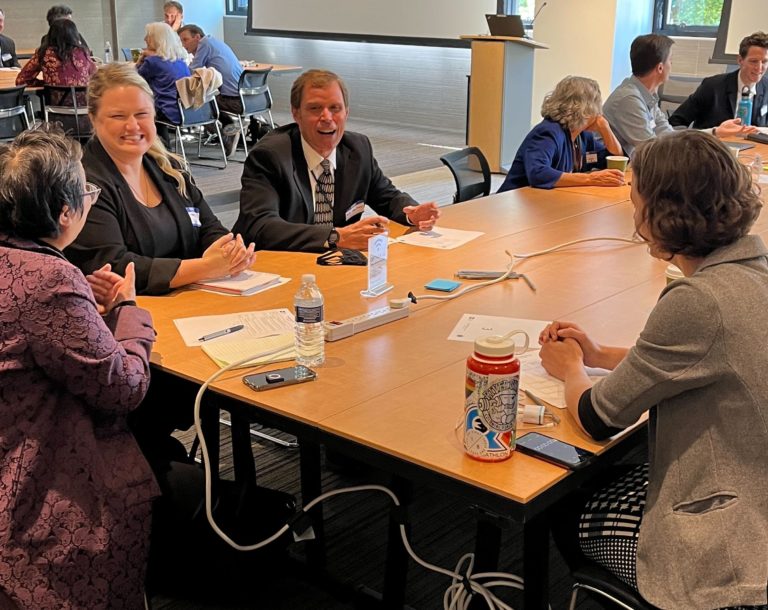
Looking ahead
A lot of great stuff happened during the Forum itself. But I’ve been even more excited to witness the follow-on in the weeks since. Motivated by the Forum, agencies are already taking concrete steps to scope intergovernmental research and evaluation consortia for other policy domains, update existing surveys with unmet desire questions, reframe public values as empirical evidence, and consider what support and guidance is needed to position Living Evidence as a standard component of the federal evaluation toolkit.
And I am confident that, in what remains of the White House Year of Evidence and thereafter, much more exciting work is to come. To echo the words of Sir Jeremy Farrar (Wellcome) during his Evidence Forum keynote address,
This is the moment for us to grasp—not in fear, not in uncertainty, not to be down beaten by the challenges the world faces at the moment. But to say that we actually can make the world a better place.
How could anyone be skeptical of that?
Missed the Forum? A full recording can be accessed here, using the passcode vm6?$rK%
See this whitepaper recapping the event in more detail for additional policy recommendations.
FAS Symposium Provides Recommendations to Next Administration on Catastrophic Threats
On November 9, 2012, FAS hosted the Symposium on Preventing Catastrophic Threats at the National Press Club in Washington, DC. The symposium consisted of three panels that explored catastrophic threats to national and international security, including those posed by nuclear and radiological weapons; biological, chemical, cyber, and advanced conventional weapons; and threats to energy supply and infrastructure.
Distinguished panelists at the symposium offered recommendations to the Obama administration on dealing with these challenges. The following summary offers a glimpse of the issues raised and points made throughout the day. A more detailed account that includes each speaker’s memo to the president is also available in FAS’s symposium report, Recommendations to Prevent Catastrophic Threats.
Nukes, Nukes, and More Nukes
The first panel of the symposium addressed a complex set of problems regarding nuclear weapons. Mr. David Hoffman of the Washington Post served as moderator of the panel.
Dr. Sidney Drell, Deputy Director Emeritus of SLAC National Accelerator Laboratory, began by arguing for a reduction in the nuclear stockpiles leftover from the Cold War, renewed talks for data exchange, and increased transparency. Drell proposed reducing nuclear weapons to 1,000 or fewer. Also, he recommended that the United States and Russia create a Joint Data Exchange Center, which would foster cooperation between the two nuclear powers and provide added protection against conflict resulting from misinterpreted data. In the end, he questioned if the United States could escape the “nuclear deterrence trap.”
Dr. Richard L. Garwin, IBM Fellow Emeritus of the Thomas J. Watson Research Center, commented that nuclear weapons are a threat more than a tool, since just one nuclear explosion would cause massive destruction and death. Among the known concerns of bloated stockpiles and Pakistan’s nuclear program, Garwin addressed the possibility of improvised nuclear explosives of a “yield comparable with that of the Hiroshima or Nagasaki bombs.” He said the administration should discuss several topics together, including the role of nuclear weaponry in U.S. military forces and the managing the risks and rewards of technology built around nuclear fission. Garwin recommended that the United States remove B-61 bombs from Europe and spoke against the tendency to focus on only those issues deemed to have the highest priority, arguing the United States had enough resources to work on all of these issues at once.
Mr. Charles P. Blair, Senior Fellow on State and Non-State Threats at FAS, described a new paradigm for countering the threat of radiological and nuclear terrorism. He cautioned against presupposing that all violent non-state actor groups represent a potential nuclear threat. The counter-nuclear terrorism paradigm predicated on this assumption is costly, inefficient, and, ultimately, cannot be sustained. Blair explained that ideology indicates whether a terrorist organization would seek out and use nuclear weapons. Some terrorists might be more likely to seek a nuclear weapon given their unlimited objectives and belief in divine orders. Others will have different aims. He recommended more robust efforts to understand terrorist ideology and also their behavior after acquiring a nuclear weapon, including their likely command and control structure.
Dr. Robert S. Norris, Senior Fellow for Nuclear Policy at FAS, recommended that the Obama administration eliminate all but one mission for nuclear weapons: deterrence, narrowly defined as preserving the means for retaliation if anyone uses nuclear weapons against the United States or certain allies. Norris questioned whether the changes to U.S. nuclear policy were real or illusory, and noted the ability of bureaucracies to maintain the status quo. However, changes are necessary, Norris argued, especially with U.S. nuclear war planning – only this will allow for reductions of nuclear stockpiles.
Mr. Hans Kristensen, Director of the Nuclear Information Project at FAS, concluded the panel by analyzing the current world nuclear force structure. He argued that Russia has already moved below the New START upper limits, and they will go lower. A similar response by the U.S. would indicate our cooperation. Obama said that the U.S. needed to move away from “Cold War thinking.” Kristensen recommended reductions in the nuclear arsenal and delivery systems. One recommendation included reducing the ICBM force from 450 to 300 missiles.
The panelists addressed the nuances of nuclear weapons. All called for greater comprehension of the complexity of the problem by Obama’s administration rather than restrictive labels that indicate maintaining the status quo.
Biological, Chemical, Conventional and Cyber Threats
The second panel at the symposium discussed the threats posed by biological, chemical, conventional, and cyber weapons. Ms. Siobhan Gorman, Intelligence Reporter at the Wall Street Journal, moderated the discussion.
Mr. Matt Schroeder, Director of the Arms Sales Monitoring Project at FAS, began by describing the complexity of conventional threats, choosing to focus on the subcategory of small arms and light weapons (SALW). He explained that SALW posed the “most immediate, multi-faceted threat to U.S. interests abroad.” Mr. Schroeder argued that the United States needed to include parts, accessories, and ammunition in its definition of SALW when discussing arms control. “Without ammunition,” he said, “small arms and light weapons are useless.” Mr. Schroeder explained how SALW pose a threat because they are the “weapons of choice” for transnational forces. In particular, transnational forces favor MANPADs (man-portable air-defense systems); they are easily transportable and can do significant damage to aircraft. He recommended that the United States expand the stockpile security and destruction aid programs, targeting surplus arsenals of MANPADs that can easily be sold on the black market.
Dr. Kennette Benedict, Executive Director of the Bulletin of the Atomic Scientists, followed by reiterating the Obama administration’s principles for cyber security, emphasizing the need for adequate defenses for the private sector. She said that the administration currently does not outline rules for cyber-attacks on other countries’ infrastructure. Dr. Benedict pointed out that current U.S. policy views cyber-attacks by another government as an act of war, allowing the United States to respond with military means. However, if a non-state actor employs a cyber-attack, then it is a criminal act. Dr. Benedict noted the difficulty in finding the origin of a cyber-attack; in fact, an individual can assume the identity of a state for a cyber-attack. She recommended that a “good defense is a good offense,” yet it could have unintended effects. Moreover, she stressed the importance of pursuing a deeper level of understanding of the relationship between cybersecurity operations to protect infrastructure and other efforts to ensure the availability and usability of cyberspace for communication, commerce, and free speech.
Ms. Marina Voronova-Abrams, Program Associate at Global Green USA, began the discussion on chemical and biological threats. She reminded the panel that several states are not parties to the Chemical Weapons Convention, including Syria and North Korea among others such as Angola, Egypt, Israel, Myanmar, Somalia, and South Sudan. Ms. Abrams called for more inspections, yet calculated the enormous number needed given that there are 4,913 declared dual-use industrial facilities across the globe. She highlighted the importance of the United States completing the destruction of its chemical weapons stockpile and then turned to the issue of biosecurity threats in the former Soviet Union. Though the threat has decreased and there is little possibility of someone using a bioweapon inside the former USSR, Ms. Abrams explained how terrorists could use their contacts in the former Soviet Union to gain access to bioagents.
Dr. David Franz, Senior Advisor to the Office of the Assistant to the Secretary of Defense for Nuclear, Chemical, and Biological Defense Programs, quoted Dr. Joshua Lederberg who stated that “there is no technical solution to the problem of biological weapons […] but would an ethical solution appeal to a sociopath?” Excessive regulatory requirements can hinder productivity and creativity in the life sciences, but it is the risk that the United States has been willing to take to address the insider threat. However, looking abroad he emphasized the importance of the human dimension to biosecurity and the personal relationships among scientists, which allow not only for early warning of natural or accidental outbreaks of diseases but also for sustained, collaborative efforts that extend beyond the initial engagement phase of international outreach. Dr. Franz explained how the United States cannot lead with security in these relationships; rather, an emphasis on public health is more appropriate for tackling biosecurity challenges collaboratively. This is especially important for countries whose concern with their existing disease burdens greatly exceeds their concern for what the United States deems “especially dangerous pathogens.” Hence, Dr. Franz proposed policies that foster relationships between scientists.
Energy and Infrastructure
The symposium concluded with a panel on the issues surrounding energy and infrastructure. Mr. Miles O’Brien, Science Correspondent at PBS NewsHour, moderated the panel.
Dr. John Ahearne, former NRC Commissioner and the 2012 recipient of FAS’s Richard L. Garwin Award, began the discussion by analyzing the 2011 Fukushima nuclear accident. He explained how risk analysis recommended a higher wall against tsunamis given events in the area one thousand years ago. Yet, decision makers chose a study using events in Chile in regards to earthquakes to use as the basis of their safety designs. Thus, the plant chose to build a 20-foot wall rather than the 50-foot wall proposed by the former study. He argued that this is not a lesson against nuclear power, but the problem of regulators and operators. Dr. Ahearne advised against the International Atomic Energy Agency (IAEA) assuming the role of global regulator; rather, regulation is a national duty. However, he also noted that regulation is not the only solution; states must ensure that operators take on ensuring safety as their duty.
Dr. Steven Koonin, Director of the Center for Urban Science and Progress at New York University, argued that energy policy “success” is achieved mostly through appropriate structures and processes. He called for the establishment of a Quadrennial Energy Review (QER) process to guide energy policy. He also asserted that, ultimately, changes to the energy structure are “in the hands of the private sector.” It requires a mix of business regulations and technology development with attention paid to private sector considerations. Dr. Koonin recommended that energy policy separate stationary from transport sectors, something that is done practically yet not in policy legislation. As a result, he argued that energy policy focuses too much on stationary research and development given the importance of transportation and oil.
FAS President Dr. Charles D. Ferguson, concluded the panel by discussing international science partnerships and their role in national security. For example, FAS’s pilot project in Yemen, the International Science Partnership, is a science diplomacy initiative that brings scientists and engineers from the United States together with their counterparts from countries of security concern to solve critical water and energy security issues. Dr. Ferguson recommended specifically that the Obama administration should ensure that there are a sufficient number of scientists and engineers in government, especially in agencies such as USAID and the Department of State to facilitate science diplomacy.
Meggaen Neely was an intern communications at the Federation for American Scientists during the Fall 2012 semester, and is currently interning at the Center for Strategic and International Studies. She coordinated authors for the Up for Debate project, worked on the Did You Know Campaign and wrote accounts of events hosted by FAS. Neely is pursuing a Master of Arts in security policy studies at The Elliott School at George Washington University. She comes to Washington, DC with a Masters of Public Policy and Administration and a Bachelor of Arts in political science from Baylor University.
Photography by Monica Amarelo.
